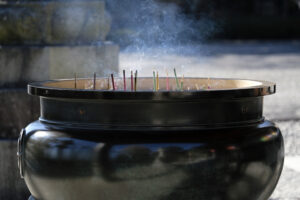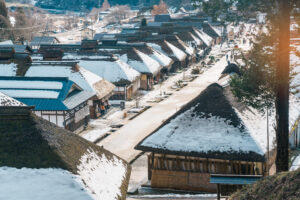Nestled within the rich tapestry of Japan’s history lies the Jomon Period, a fascinating epoch that heralds the dawn of Japanese civilization. Stretching from about 14,000 B.C. to around 300 B.C., this era predates the influences of rice agriculture and metal tools that shaped later periods. Recent excavations and scholarly studies have begun to peel back the layers of time, offering us a glimpse into the lives, cultures, and environments of the Jomon people. This article aims to unveil the secrets of Japan’s ancient Jomon Period, exploring everything from their daily lives and diets to their spiritual beliefs and artistic endeavors.
Unearthing the Secrets of Japan’s Ancient Jomon Period
In the heart of Japan, archaeologists have been meticulously unearthing the secrets of the Jomon Period, revealing a civilization that flourished long before the advent of written history. These excavations have brought to light a plethora of artifacts, including pottery, stone tools, and remnants of dwellings, providing invaluable insights into the lives of the Jomon people. With each discovery, the veil over this enigmatic period lifts a bit more, allowing historians and archaeologists to piece together the puzzle of Japan’s ancient past. The ongoing research continues to challenge previous assumptions about the Jomon Period, suggesting it was a time of significant social complexity and cultural diversity.
Jomon Era: The Dawn of Japanese Civilization
The Jomon Era represents the dawn of Japanese civilization, a period marked by the development of sedentary communities and the advent of pottery making, fishing, and hunting techniques. This era witnessed the emergence of some of the earliest known pottery in the world, characterized by intricate designs and patterns. The Jomon people’s ability to adapt to their environment and make use of its resources played a crucial role in their survival and the shaping of their society. As researchers delve deeper into this period, they uncover evidence of a people who were not only survivors but also innovators, laying the foundation for future generations.
The Jomon Period: Exploring Life 16,000 Years Ago
Life during the Jomon Period was deeply intertwined with the natural world. The changing seasons dictated the rhythm of life, from fishing runs to nut gathering. The Jomon people were hunter-gatherers who also engaged in early forms of agriculture, such as the cultivation of plants like the lacquer tree, which was used for making lacquerware. Their settlements, often located near water sources, were made up of pit dwellings that provided shelter from the elements. The community was the heart of Jomon life, with evidence suggesting a rich cultural life that included rituals, festivals, and art.
From Pottery to Pit Dwellings: Jomon Culture Unveiled
Jomon culture is perhaps best known for its pottery, which ranges from simple cord-marked pieces to elaborate figurines and vessels. The craftsmanship of these items speaks volumes about the artistic sensibilities of the Jomon people and their connection to their environment. Beyond pottery, the architecture of their pit dwellings reveals a practical understanding of their surroundings, utilizing materials at hand to create comfortable living spaces. The social and spiritual life of the Jomon people can also be glimpsed through the artifacts left behind, suggesting a society with complex beliefs and rituals.
Deciphering the Mysteries of Jomon Artifacts
The mysteries of Jomon artifacts lie not just in their beauty but in what they tell us about the people who created them. Each piece, from the smallest bead to the most intricately decorated pottery, provides clues to the daily lives, social structures, and even the diets of the Jomon people. Researchers use a variety of techniques, from carbon dating to microscopic analysis, to unlock the secrets these artifacts hold. Through careful study, the story of the Jomon Period is slowly being reconstructed, shedding light on a civilization that was both sophisticated and in harmony with the natural world.
Jomon Period Diet: From Fish to Nuts
The diet of the Jomon people was as varied as it was nutritious, relying heavily on the abundance of the land and sea. Archaeological evidence points to a diet that included fish, shellfish, nuts, seeds, and wild plants. The diversity of their food sources is a testament to the Jomon people’s deep knowledge of their environment and their ability to adapt to seasonal changes. This varied diet not only sustained them but also allowed their population to grow and their culture to flourish over thousands of years.
The Spiritual World of the Jomon People
The spiritual world of the Jomon people is intricately linked to their natural environment, as seen in their art and burial practices. Clay figurines, known as dogu, along with other ritualistic artifacts, suggest a belief system that revered both the tangible and intangible aspects of their world. These objects, often found in burial sites, indicate a complex spiritual life that included rituals for birth, death, and the changing seasons. The Jomon’s spiritual practices reflect a deep connection to their surroundings, offering a fascinating glimpse into their worldview.
Trade and Technology in the Jomon Era
Evidence of trade and technological innovation during the Jomon Period suggests a society that was not isolated but was actively engaged with neighboring regions. The discovery of obsidian tools, which originated from sources hundreds of kilometers away, indicates a network of trade that facilitated the exchange of goods and ideas. The Jomon people’s technological achievements, including pottery kilns and stone tools, demonstrate a keen understanding of their materials and a constant pursuit of improvement.
The Evolution of Jomon Pottery Styles
The evolution of Jomon pottery styles over the millennia provides a visual timeline of the period’s development. From the earliest cord-marked designs to the elaborate final-phase pottery, the changes in style and technique reflect broader shifts in Jomon society. These pieces are not only artistic expressions but also markers of social and environmental changes, offering clues about the settlements’ interactions and the challenges they faced.
Jomon Period Settlements: Understanding Ancient Societies
The study of Jomon Period settlements has revealed a great deal about the social and economic structures of these ancient societies. The layout of these communities, the size of their dwellings, and the distribution of artifacts provide insights into the lives of their inhabitants. From small hamlets to larger villages, the organization of space within these settlements speaks to a society that was both cooperative and complex.
Climate Change and Its Impact on the Jomon Period
Climate change played a significant role in the development and decline of the Jomonsociety. Fluctuations in temperature and sea levels affected the availability of resources, forcing the Jomon people to adapt to new environments. The resilience of the Jomon people in the face of these challenges is a testament to their ingenuity and their deep bond with the land. As modern researchers piece together the impact of these climatic shifts, they gain valuable insights into how ancient civilizations responded to environmental changes.
The Legacy of the Jomon Period in Modern Japan
The legacy of the Jomon Period lives on in modern Japan, influencing everything from its art to its spiritual practices. The deep respect for nature, so evident in Jomon culture, remains a cornerstone of Japanese philosophy. The era’s pottery styles inspire contemporary artists, while its spiritual beliefs resonate in the rituals still practiced today. By exploring the Jomon Period, we gain not only a deeper understanding of Japan’s ancient past but also a greater appreciation for the cultural richness that continues to shape the nation today.
The unraveling of the Jomon Period offers a unique window into the early dawn of Japanese civilization, revealing a society that was both complex and in harmony with its environment. As researchers continue to unearth its secrets, the Jomon Period promises to provide further insights into the origins of Japanese culture and the enduring legacy of its people. Through the meticulous study of its artifacts, settlements, and environmental impact, we are reminded of the intricate web of connections that bind humanity to its past and to the natural world. The Jomon Period, with its rich cultural tapestry and technological ingenuity, stands as a testament to the enduring spirit of innovation and resilience that defines human history.








